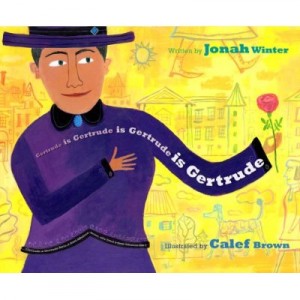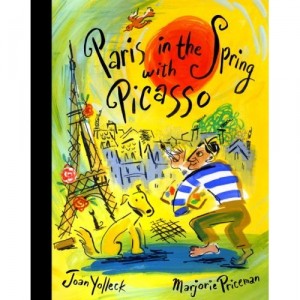
San Francisco In the Spring With Gertrude Stein
Soon the museum gates will open and entire families will stroll into “Seeing Gertrude Stein: Five Stories” and “The Steins Collect”. What will the kids make of the fat lady who doesn’t sing?
Do they need help? Looking at the books out there, it is maybe the parents who need help. Or maybe not. There aren’t many helpers. Adult witticism and playful attempts to approach Stein don’t always fly with kids who are easily bored with teachers and well-meaning preachers of art or avant-garde. They sniff out in an instant if someone is talking down to them.
There is Gertrude is Gertrude is Gertude, by Jonah Winter, illustrated by Calef Brown, a big-format picture book (and Junior Library Guild Selection) with big-letter text in Steinese style about a “tea party” at her place: “This is the place to be, YES it is.”

The story gets Picasso, Matisse and Hemingway there for tea and gets a few things right — mostly about Picasso: “Pablo Picasso looks so angry but NO. Pablo Picasso is Pablo PICASSO. He just invented Modern art which is not the same thing as being angry but then again maybe it is. Maybe it is and maybe it isn’t.” The book gets a few things wrong about Gertrude herself, first when people walk up some stairs (?) “to greet her majesty, Queen Gertrude.” Queen Gertrude? By the time Hemingway came to the salon, Stein had cut her hair and acquired the look of a Roman emperor. King Gertrude would be more like it. (Which reminds me that in a notable theater production, a play called Now Repeat in Steinese, performed in Edmonton, Alberta (Canada), Stein was recently played smashingly by a MAN.) Also more than questionable: “Miss Gertrude is just so so so happy as a baby, so happy. And Alice is happy, happy as a mother…” Excuse me? A mother-baby couple? Young readers certainly don’t get the queer view here that is in fashion at our day and age.
More joyous is Paris in the Spring with Picasso, by Joan Yolleck, illustrated in radiant, fauve colors by Marjorie Priceman.

The charming walk of artists from their ateliers to the Rue de Fleurus unites Picasso, Fernande, and Frika (their dog), Apollinaire, Marie Laurencin, and Max Jacob in instantly recognizable, charming sketches. The little caravan walks all the way through Paris, from Montmartre past the Cirque Medrano with a marvelous elephant, past the Eiffel Tower and Notre Dame, crosses over the Seine to the left bank and St. Germain and ends chez Gertrude and Alice with Gertrude’s hearty laugh and the question, what might they all be talking about?
A rather adult question, however. Does any kid care? This time, Alice is coyly called “Gertrude’s best friend”, but at least Alice looks charmingly exotic, her “big Gypsy earrings jingle” and the two women call each other “Sweetie”, “lovie” and “my birdie.” Maybe that conveys the message. Maybe not.
Kids and parents may have to wait for the soon-to-come truly funny kid-book Gertrude and Alice and Fritz and Tom, by Hans Gallas, illustrated by Tom Hachtman. Two American boys visit Gertrude and Alice at the Rue de Fleurus… There is immediate cross-cultural and cross-generational interest. More shall not be revealed. Just that the famed cartoonist Hachtman has a ball with his cubist caricatures of Alice, his droll, Humpty-Dumpty-fatty Gertrude, and the two naughty and of course adorable boys.
In the meantime, why not turn to the author herself? Not too surprisingly, in fact, she does it best.
The Gertrude Stein First Reader and Three Plays was conceived as a “primer” for children, with 20 poetic, corky, dark “lessons” about kids and animals (a dog tries to learn to read – and fails, like the kids themselves). The texts are short and amusing to read aloud.
Try, for example, Lesson Seven:
“By the time dates are ripe, by the time bananas are yellow, by the time olives are green by the time there is no in between, by the time it is time to get up and be sleepy by the time all the words are written by the time chocolate is sweet and sugar is eaten by the time oranges grow and they all say so, by the time it is hot in summer and cold in winter by the time any boy sees by the time any girl knows by the time one is one and two is two by the time three and three make six, by the time shells have no fishes by the time water is blue by the time children are lost by the time too they are found through having been put to, work and play too, by the time it is not easy to have to do what they do by the time they are through they two can read one and two and you and true, so they do.”
No adult here talking down or lecturing or explaining or boring you… What she writes is simple, not simplistic. Instead of being childish and sweetish, there is always a dark untertow. In brief, there’s a master at work.
Too bad though that the book isn’t easy to find. Illustrated in 1941 by Sir Francis Rose, it is out of print and can be found as a rare book or perhaps an e-book. If you are adventurous, you’ll find it at Amazon.de, in a two-language, German-English edition from 2001, Gertrude Stein: The First Reader (Ritter Verlag) with highly artistic, child-like and grotesque drawings by Günter Brus.
Available, of course, is Stein’s evergreen The World is Round, the children’s book in which a little girl called Rose carries a blue chair up a mountain and then writes her name all around a tree until “Rose is a rose is a rose is a rose” – the most famous line of modern American literature that “completely caressed completely caressed and addressed a noun,” as Stein explained later, on her America tour. No kid needs an explanation. The book (now in a Shambala edition from 1993, illustrated by Roberta Aronson) begins with another greatly unusual line for a childrens’s book that any kid will connect with on the spot:
“Once upon a time I met myself and ran.”




Pingback: Why Do Something If It Can Be Done: Quoting Gertrude Stein # 82 « Renate’s Website